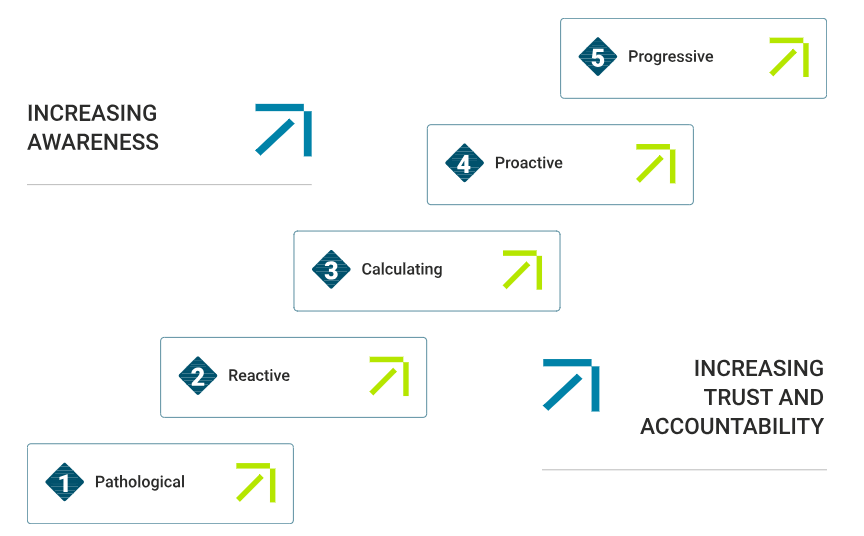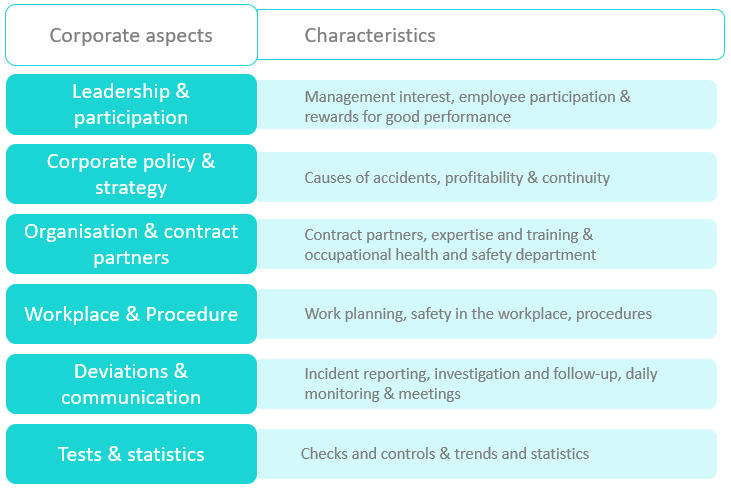Safety Culture Ladder
The Safety Culture Ladder (SCL) promotes safety awareness and conscious, safe behaviour. The aim is to reduce unsafe situations and incidents.
Safety Culture Ladder
The Safety Culture Ladder (SCL) promotes safety awareness and conscious, safe behaviour. The aim is to reduce unsafe situations and incidents.
Awareness of personal responsibility for safety at all levels of an organisational structure has a major influence on safety. Behaviour, culture and attitude play an important role here. With the concept of the Safety Culture Ladder, an organisation can determine its level of maturity with regard to occupational safety and improve level by level. Recognising progress has a motivating effect to become even better.
Summary
In principle, the core concept of the Safety Culture Ladder can be applied anywhere. At the same time, the concept can be adapted to specific sectors, for example by adapting requirements and criteria to the respective industry or type of company.
The Safety Culture Ladder consists of five levels that categorise occupational safety awareness and behaviour within a company. The greater the sense of responsibility, reflexivity and efforts to improve safety, the better the assessment and the higher the assigned level based on the assessment criteria.

Level 1: Pathological
The company's attitude is: "We don't have any breakdowns and we deliver good quality. So why should we waste time on prevention measures?" and "What I don't know won't make me hot". The company invests little to nothing in health and safety behaviour. This attitude is not desired and is therefore not rewarded.
Level 2: Reactive
The company tends to make changes only after errors have occurred. The reaction is based on deeply rooted patterns. Employees tend to feel like victims of a situation and not personally responsible. "But what can I do about it?" Change behaviour is often spontaneous and short-term. This behaviour is rated as moderately positive.
Level 3: Cumulative
The company has defined the safety regulations that are relevant to it. However, this approach is not followed consistently, as although responsibility is assumed, this is often motivated by self-interest. "What's in it for me?" Commitment to safety and compliance with laws and regulations is primarily the responsibility of (senior) management. There is an awareness of occupational health and safety; this is viewed positively.
Level 4: Proactive
Safety is a high priority and is deeply embedded in the company's operating processes. There is continuous investment in raising health and safety awareness and employees are encouraged to speak to each other about dangerous behaviour. Improvements are structurally implemented and evaluated. This approach is characterised by proactivity and initiative. Health and safety awareness is seen as the responsibility of each individual: "What contribution can I make?" This form of behaviour is seen as very positive.
Level 5: Innovative
Safety is an integral part of operational processes. Safety is an integral part of reflections and evaluations within the company and with other sector parties. Safety is firmly anchored in the thinking and behaviour of all employees. Safety is an integral part of their work. This behaviour is seen as very positive.
Assessment criteria
For each level, it defines what the company must provide (requirements), which accompanying criteria are applied (standard), how these criteria are weighted (assessment) and what the independent auditors should pay attention to (guidelines for auditors). This is based on six perspectives or company aspects. These are in turn divided into 18 company characteristics, each of which is assigned a weighting factor.
The position of a company on the Safety Culture Ladder is determined by the highest level whose requirements the company fulfils. More information on requirements, standards, assessment and guidelines can be found in the certification scheme for the Safety Culture Ladder
.

Development
The Safety Culture Ladder was developed by ProRail to increase safety awareness among employees in the Dutch railway infrastructure.
Since 1 July 2016, the Safety Culture Ladder has been a product of NEN (Nederlands Normalisatie-Instituut, Nederlands). NEN is internationally recognised as an administrator of certification systems.
NEN is responsible for the project management and supervision of the Committees of Interested Parties (AdI) and Committees of Experts (AdE).
The audits are carried out by independent, accredited assessment companies (certification bodies).
Further development:
SCL continues to develop based on the experience gained and becomes SCL 2.0.
SCL 2.0 is valid from 01 January 2024.
Transitional regulations to version SCL 2.0:
- The transition period is 3 years.
- Certificates in accordance with SCL 1.0 with a 3-year validity can continue to be awarded until 31 December 2024.
- From 01 January 2025, initial certifications/certifications according to SCL 1.0 are no longer possible.
- The change takes place on the occasion of a recertification.
Education
If you would like to find out more quickly and would also like to ask questions:
Register for our SCL briefing (free of charge).
Please enquire for dates.
